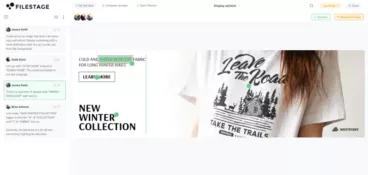Did you know that we’re exposed to anywhere between 4,000 to 10,000 ads per day? Yeah, I was also shocked. But, if I asked you to name a great ad you’ve seen recently, you’ll likely struggle to name even one.
In this sea of advertisements, we’ve basically trained our brains to ignore the vast majority of ads and focus on the content we’re looking for.
So how can you create an ad that stands out among the rest? What elements does it need? And what will make it so appealing that your audience can’t help but take action?
To help you get answers to these questions, I came up with a comprehensive guide for creating unique and successful ads.
So let’s begin with the basics.
Five essential elements every ad campaign needs to have
Before you start creating your ad campaign, you need to understand the essential elements of every ad. These will help you create a successful campaign that everyone will talk about.
Here’s a quick overview:
- Objective
- Compelling message
- Creative visuals
- Call to action
- Consistency
1. Objective
Every project needs an objective. Because how are you going to know if something is successful without a clear objective? When it comes to advertising, your objective doesn’t always have to be conversion into sales. It can be a number of different things.
Here are some objectives you can set for your campaign:
- Increase brand awareness – Your ad can have the sole purpose of raising awareness of your brand among your target audience. These types of ads are often more creative, prioritizing style and brand over products.
- Drive sales or conversions – You can create ads where you encourage consumers to make a purchase or take an action, like signing up for a service, downloading an app, or requesting a demo.
- Generate leads – Some ads have a goal to capture contact information from potential customers who have shown interest in your product or service. This is a common objective in B2B marketing and industries with longer sales cycles.
- Promote product or service launch – Create buzz and excitement around your new product or service entering the market with ads that serve as teasers for your audience.
- Educate or inform – You can even create ads that provide valuable information or insights to your audience, positioning your brand as a trusted authority in your industry. This objective is particularly effective for complex or innovative products in highly-regulated industries.
Supercharge your marketing reviews
Share, review, and approve all your content in one place with Filestage.
2. Compelling message
Some of the best ads are considered the best because of their smart language that hits the right spot for the audience. The right message can be brought through humor, by stating the obvious truth, or creating an emotional appeal. Whatever that is for your ad, it’s important to find it and shape your message around it.
One thing that can help you set the right tone and deliver a compelling message to your target audience is by looking closely at who your audience is, and making sure you’re speaking to them. But more on that later.
The key thing to remember with your messaging is to make it authentic. Here are some false advertising examples to show what can happen when brands get things wrong.
3. Creative visuals
It’s no news that we all love consuming visual content.
In fact, a study by Xerox found that your audience is 30% more likely to send payment when visuals are included in your marketing. So instead of only focusing your efforts on strong copy, make sure you build creative visuals into your ads.
This can include images, videos, GIFs, infographics, or graphics. Whatever works best for your audience!
4. Call to action
Every ad needs to be followed by a strong call to action. As the name suggests, a call to action is a specific action you’d like your audience to take after seeing your ad. And you have to define your call to action depending on the objective you set in the beginning.
Would you like your audience to go and purchase your product? Or maybe to visit an educational site where they can find more information about your service? They can even leave information like their email address as a result of your ad. Whatever it is, it’s important that your CTA serves your main objective.
5. Consistency
Last but not least, is the consistency in your advertising. In ads, consistency refers to many different things. Your ad needs to consistently use the same language, colors, and visual representation. It needs to appear regularly in the lives of your target audience. And it has to consistently serve the same goal throughout the entire campaign.
In short – consistency is the key for every successful ad campaign.
Six steps for making a killer ad
Now that you know everything your ad needs to succeed, here’s a quick step-by-step guide on how to connect those elements.
1. Know your target audience
The first step in creating a successful ad is knowing your audience well. That doesn’t just mean their demographics but also their preferences, passions, fears, and pain points when it comes to an issue your product or service resolves.
Only when you know your audience this well will you be able to create an ad that resonates with them.
A great example of a brand that knows its real audience well and communicates with them perfectly is De Beers Jewellers. Instead of orienting their ads towards women – the obvious consumers of their product, the brand focused all its attention on the buyers – the men.
With a range of hilarious posters, the brand points out pain points and common stereotypes in male-female relationships, ultimately giving their audience all the reasons why they need to purchase their jewelry.

Source: pinterest.com
2. Come up with a bulletproof ad strategy
Behind every successful ad is a bulletproof strategy. Your strategy should combine the knowledge you have of your audience with the objectives of your campaign and turn them into concrete actions.
As part of your strategy, define when and where you’ll publish your ad, and the exact ad creative that will go with it.
Need help getting started? Check out our eight steps to develop a successful marketing strategy.
3. Create assets
Whether you choose to promote your product in a print magazine, on a billboard, or on the web, you’ll always need a series of campaign assets to create. Most likely you’ll be creating ads for various different platforms, so it’s important to have all the creative ready before publishing.
Here are some examples of creative assets you might want to have for your next ad campaign:
- Banner ads – Static or animated images for online advertising
- Video ads – Commercials or short videos for TV, online platforms (YouTube or social media), or digital displays
- Landing pages – You can create a dedicated landing page for a certain event or cause to promote it
- Social media posts – Images, videos, stories, carousels, and text posts for platforms like Facebook, Instagram, X, LinkedIn, and TikTok
- Print ads – Ads for newspapers, magazines, flyers, brochures, and posters
- Point of sale – Window displays, ceiling hangers, and other in-store ad displays
- Email campaigns – Promotional emails, newsletters, and personalized messages
- Radio ads – Audio spots for radio or streaming services
- Outdoor ads – Billboards, transit ads, and digital signage
4. Collect all approvals
With many assets at hand, it’s often hard to keep track of which got approved, and which still needs to be approved before publishing. Especially if you collect feedback and approvals through email.
That’s why it’s important to establish a smooth approval workflow for every ad project you create. A dedicated review and approval platform like Filestage brings all your assets and reviewers together in one place to discuss feedback and centralize approvals.
Add relevant video
This way you always know the exact status of each asset and can make sure they get approved before the deadline. Plus, you can also create separate reviewer groups for different types of stakeholders – like agency, marketing, and legal.
Most importantly, if you’re creating ads in a regulated industry, you can easily create a separate reviewer group for compliance. This gives you the peace of mind that everything you print or publish has gone through your lawyers or regulatory team first.
5. Choose the right ad platforms
Not every ad or every company should be present on the same platforms. Based on your target audience, the topic of your ad, and the goals you’re trying to achieve, it’s important to find the right platform for your ad.
For example, if you’re advertising a pharmaceutical product mostly used by an older generation, you’ll probably turn to TV advertising. On the other hand, if you’re promoting the latest lip gloss to Gen Z, you’ll need a strong presence on TikTok.
And if you’re creating a big campaign for a rebranding of a telecommunication company, you’ll probably use multiple platforms, including both digital and traditional advertising channels.
6. Test and measure the impact of your ad
One of the biggest perks of digital advertising is the possibility to track and measure the impact of your ad from day one of its release. You can track all sorts of data, including click rates, impressions, or conversions. This way you can easily compare ads and see what works for your audience and what needs improvements.
You can also A/B test your ads, experimenting with copy and creative assets to see which version resonates best with your audience.
By measuring the impact of your ads, you’ll be able to put all the numbers into perspective and see whether your ad fulfilled all the goals and objectives. And if it didn’t you’ll simply know what to change the next time.
Digital vs. traditional ad formats
There are many different types of ads you can choose from. And the decision about which type of ad will work the best for your brand should be equally strategic and creative.
Here’s a list of digital and traditional ad formats you can choose from.
Digital ad formats
There are many digital ad formats you can use for your campaign. After all, pretty much every digital platform relies on advertising revenue to survive.
Here are some examples:
- Video ads
- Facebook ad
- Instagram ads
- Google ads
- Banner ads
- Carousel ads
- Audio ads
- YouTube ad platform
Traditional ad formats
Before the world of advertising went wild with digital ads, traditional media was all the rage. Whether you’re looking to increase brand awareness at scale or advertise your product within a niche audience, traditional ad campaigns can have a huge impact.
Here are a few examples::
- TV ads
- Cinema ads
- Print ads
- Out of home (OOH) ads
- Direct mail
- Point of sale (POS)
- Radio ads
Final thoughts
Creating an ad these days isn’t exactly rocket science. You can use a free ad maker, watch a few YouTube tutorials, and you’ll have it. But creating a successful ad that helps your brand increase awareness and sell more products in the sea of competition can be pretty tough.
Hopefully these tips and tricks help you deliver a killer ad that stands out!
And if you’re looking for a simple and straightforward feedback and approval solution to help you streamline your ad production, make sure to give Filestage a try!








